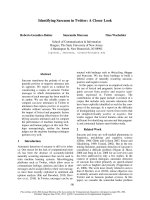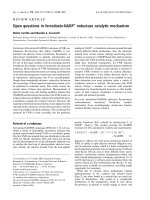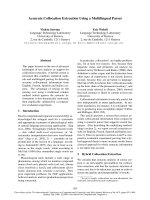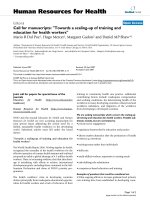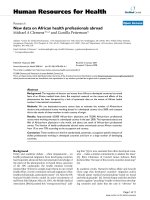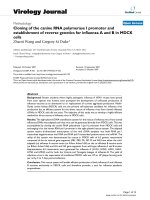Báo cáo sinh học: "Open questions about influenza A (H1N1) 2009" docx
Bạn đang xem bản rút gọn của tài liệu. Xem và tải ngay bản đầy đủ của tài liệu tại đây (61.16 KB, 2 trang )
Robertson: Journal of Biology 2009, 8:68
When influenza A (H1N1) 2009 first started to spread on a
pandemic scale earlier this year, we asked Peter Doherty
and Stephen Turner to write a Question-and-Answer piece
for us on the virus and the means to combat it [1]. Now,
with the return to school of children at the start of the
Northern Hemisphere autumn and the expected new wave
of infections, we have published a follow-up Q&A [2] on
what we have learned about the virus since the last article,
and the likelihood of an increase in the severity of the
disease in the second wave of infections. For this, Doherty
and Turner have recruited the help of colleagues Lorena
Brown at Melbourne University and Anne Kelso at the
WHO Collaborating Centre For Reference and Research
on Influenza in Melbourne to deliver a quick overview of
what is known, and their best guesses about the practical
implications.
One question that they don’t address however is whether
the vaccines that have now been developed against
influenza A (H1N1) 2009 will be available in time to
prevent an epidemic. The vaccines are projected to be
ready from early to mid-October, and it takes about two
weeks for immunity to develop after vaccination, so if the
wave of infections grows rapidly before the end of this
month the vaccines will be too late to prevent widespread
disease. Given the importance of formulating policies for
distributing antiviral drugs and instituting social
distancing (that is, in the first instance, closing schools),
the pattern of viral spread and its consequences have been
modelled under various assumptions about
transmissibility, dependence of transmission on
seasonality, proportion of the population immunized, and
so on; and according to two modelling studies published in
BMC Infectious Disease and BMC Medicine [3,4], and a
report from the US President’s Council of Advisors on
Science and Technology (PCAST) [5], new infections may
reach their peak in mid-October, just before vaccination
campaigns can begin to take effect, and probably well
before most people can be immunized. On the other hand,
a model is only as reliable as the assumptions underlying
it, and there is no certainty that the virus will beat the
vaccines in what, inevitably, has been called a race against
time.
By contrast it does seem certain that there will not be
enough vaccine for everyone in the undeveloped world [6].
It is therefore very encouraging that preliminary results
from two recent studies published in the New England
Journal of Medicine suggest that one 15µg dose of
inactivated viral vaccine, rather than the usual two [7], or
two 7.5µg doses of vaccine with the adjuvant MF59 [8],
may be sufficient to generate protective immunity. Since
both studies measured the antibody response and not
protection from infection (with which it is highly but not
perfectly correlated), it is not yet certain that these
vaccination protocols will actually be protective. But if
they are, they will help stretch resources, not only of the
vaccine, which is cumbersome to produce (see [1]), but
also of funding and – if one dose will do – of time and
organizational effort [9]. (Adjuvants are additives that
stimulate more vigorous immune responses: the usual
adjuvants for human vaccines are aluminium salts, whose
mode of action is unknown [10]; but they do not work for
influenza virus vaccines. MF59 is a more recently licensed
oil-in-water emulsion that does work for influenza
vaccines. For an earlier comment on what we don’t know
about adjuvants see [11].)
Not the least of the unanswered questions about pandemic
influenza A (H1N1) 2009 is that of uptake. Now that
people no longer routinely lose their schoolfriends or
children to common childhood diseases that were endemic
in the first half of the 20
th
century, vaccination is too often
seen as an imposition and a threat, partly because of
publicity attendant on rare adverse reactions, or indeed
upon conditions spuriously associated with vaccination.
The recently reported death of a 14-year-old British girl
some hours after vaccination against human
papillomavirus (HPV) is therefore doubly unfortunate.
The unexpected death of a young person is shocking at any
time, but in most circumstances it is not likely to endanger
other lives. It now seems clear that the death was due to an
underlying health problem and the vaccination had
nothing to do with it; but it is a fact of human psychology
that the sudden death of a single teenage girl has more
impact than a million still-living vaccinees perhaps ten of
whom will be saved from early death from cervical cancer,
and it is devoutly to be hoped that the arousal of public
fears once again about the safety of vaccines will not
jeopardize either the HPV or on the 'swine' 'flu vaccination
programme.
Miranda Robertson, Editor
Editorial
Open questions about influenza A (H1N1) 2009
Miranda Robertson
68.2
Robertson: Journal of Biology 2009, 8:68
References
1. Doherty PC, Turner SJ: Q&A: What do we know about influ-
enza and what can we do about it? J Biol 2009, 8:46.
2. Turner SJ, Brown LE, Doherty PC, Kelso A: Q&A: What have
we found out about the influenza A (H1N1) 2009 pandemic
virus? J Biol 2009, 8:69.
3. Flahault A, Vergu E, Boëlle PY: Potential for a global dynamic
of influenza A (H1N1). BMC Infect Dis 2009, 9:129.
4. Balcan D, Hu H, Goncalves B, Bajardi P, Poletto C, Ramasco
JJ, Paolotti D, Perra N, Tizzoni M, Van den Broeck W, Colizza
V, Vespignani A: Seasonal transmission potential and activ-
ity peaks of the new influenza A (H1N1): a Monte Carlo like-
lihood analysis based on human mobility. BMC Med 2009,
7:45.
5. Cohen J: A race against time to vaccinate against novel
H1N1 virus. Science 2009, 325:1328-1329.
6. Yamada T: Poverty, wealth, and access to pandemic influ-
enza vaccines. N Engl J Med 2009, 361:1129-1131.
7. Greenberg ME, Lai MH, Hartel GF, Wichems CH, Gittleson C,
Bennet J, Dawson G, Hu W, Leggio C, Washington D, Basser
RL: Response after one dose of a monovalent influenza A
(H1N1) 2009 vaccine – preliminary report. N Engl J Med
2009, 361:[Epub ahead of print].
8. Clark TW, Pareek M, Hoschler K, Dillon H, Nicholson KG, Groth
N, Stephenson I: Trial of influenza A (H1N1) 2009 monova-
lent MF59-adjuvanted vaccine – preliminary report. N Engl J
Med 2009, 361:[Epub ahead of print].
9. Neuzil KM: Pandemic influenza vaccine policy –
Considering the early evidence. N Engl J Med 2009,
361:[Epub ahead of print].
10. McKee AS, Munks MW, Marrack P: How do adjuvants work?
Important considerations for the new generation of adju-
vants. Immunity 27:687-690.
11. Robertson M: Influenza: one or two more questions. J Biol
2009, 8:45.
Published: 2 October 2009
doi:10.1186/jbiol182
© 2009 BioMed Central Ltd
